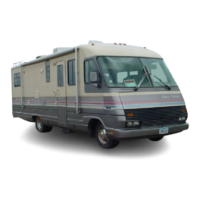79
Discovery, Discovery LXE, Pace Arrow, and
other roof openings.
Leave cabinet doors and
drawers open to facilitate
air movement behind those
areas.
Inspect and clean the
roof and sidewall seams
at least twice a year.
Inspect for exterior sealant
gaps of all roof seams,
vents, skylights, roof air
conditioners and windows.
Fuel:
Storing the motorhome with a
full tank of fuel will minimize
moisture condensing at the top
of the tank. Diesel fuel is an
organic material that can develop
microbial growth (black algae).
Fuel stabilizers may be added
to control microbe growth and
degradation of the fuel. Consult
the engine manufacturer’s owner’s
manual or a distributor for further
detailed information on fuel
stabilizers and additives.
Brakes:
Brakes suffer from non-use
during periods of storage. The
bare metal machined surfaces of
brake drums or rotors have only
a light coating of dust from the
brake lining friction material.
The brake dust is the only thing
protecting the bare metal surfaces
from rusting. Only regular brake
applications dry the moisture
preventing rust on brake drum
or rotor surfaces. During periods
of non-use, oxygen and moisture
oxidize the machined surfaces.
Only occasional use keeps these
surfaces from oxidizing. Rusty
brake drum or rotor surfaces
permeate the brake lining upon the
rst few applications, reducing the
friction action of the linings.
Engine:
Internal combustion engines
need to be “exercised” on
a regular basis to ensure an
adequate supply of lubricating
oil coats the cylinder walls and
piston rings. Valve and valve seat
surfaces also suffer from non-use.
Some valves will remain open
depending at which part of the
combustion cycle the engine has
stopped. The heat and cold of the
day allows moisture to accumulate
through the exhaust system.
Start all engines, including the
generator, at least twice a month.
Electric Motors:
Electric motors in the
motorhome should be occasionally
operated to help lubricate and
keep surfaces freely rotating.
These items include the roof
air conditioners, dash fans,
dash blower motor, furnace and
powered roof vents.
Winter Storage Checklist
Plumbing Lines -
Drain and protect. (See
Winterizing - Section 6.)
Fresh Water Tank - Drain.
Body - Clean and wax.
Reseal the roof as needed.
Countertop and Cabinets
- Wash with mild soap and
water.
Curtains - Remove and
clean according to care
specications.
Windows - To protect
interior fabric from
fading, cover windows by
pulling blinds. For Day/
Night shades cover with
a separate cover such as a
sheet or a cut out template.
Day/Night shades hold
their shape better if stored
in the up position.
Holding Tank - Drain
and rinse. Close valves.
LUBE:
Add a small amount of RV
antifreeze to waste holding
tanks to keep valves and
gaskets lubricated.
Drain Traps - Pour RV
antifreeze down all drains.
Refrigerator - Clean and
leave both doors propped
open. Cover exterior panels
and roof vents. If equipped
with an icemaker, drain
icemaker and icemaker
tray. See the refrigerator
OEM manual for more
detail.
Batteries - Add distilled
water and recharge if
needed. If necessary,
disconnect the cables,
remove the batteries and
store them in a cool dry
place. Check and recharge
as needed.
Air Conditioner - Remove
the air lters. Clean or
replace.
Roof - Keep clear of snow
accumulation or damage
may occur.
Interior/Exterior - Storing
under cover or indoors
helps extend interior and
exterior life.
Fuel Tank - Diesel fuel
tank should be full of fuel.

